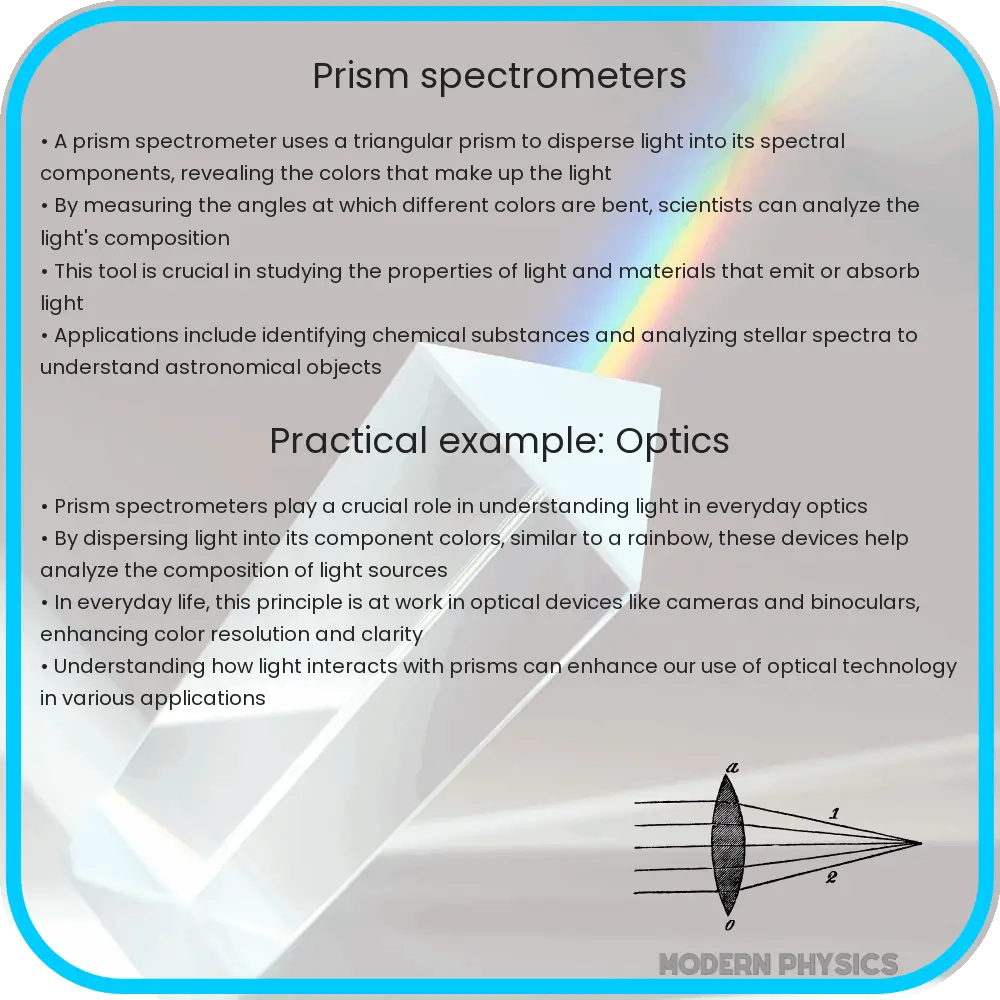Explore the precision, versatility, and wide-ranging applications of prism spectrometers in science, industry, and education. Unlock spectral secrets.

Prism Spectrometers: Unveiling the Spectrum of Light
Prism spectrometers stand as pivotal instruments in the exploration of light’s spectrum. These devices harness the refraction properties of prisms to disperse light into its constituent colors or wavelengths, revealing the hidden details of light that are not visible to the naked eye. Their precision and versatility have made them indispensable in various scientific and industrial applications, from studying atomic and molecular structures to quality control in manufacturing processes.
Precision in Measurement
At the heart of a prism spectrometer’s precision is its ability to accurately measure the angles at which light is refracted. By employing prisms made from high-quality optical materials, these spectrometers offer detailed insights into the wavelength composition of light. This precision is crucial for applications such as spectroscopy, where identifying the exact wavelengths present in a sample can reveal information about its chemical composition, structure, and physical properties.
Versatility Across Applications
The versatility of prism spectrometers stems from their adaptability to a wide range of wavelengths, including visible light, ultraviolet (UV), and infrared (IR) spectra. This makes them suitable for a diverse array of applications, from environmental monitoring and pharmaceutical analysis to astronomical observations. Moreover, the simplicity of their design allows for modifications and customizations to meet specific research or industrial needs, further extending their utility.
Usage in Modern Research and Industry
Prism spectrometers find extensive usage in both research and industrial settings. In academic and research institutions, they are fundamental tools for studying the absorption and emission spectra of various substances. This information is critical for understanding the electronic and vibrational states of molecules, aiding in the development of new materials and chemicals. In industries, these spectrometers play a vital role in quality assurance, ensuring that products meet the required spectral characteristics for performance and safety.
The applications of prism spectrometers are not limited to the visible spectrum. They are also employed in the study of substances using UV and IR light, offering insights into molecular bonds and structures that are not accessible through visible light spectroscopy. For instance, the identification of functional groups in organic compounds or the analysis of semiconductor materials relies heavily on the detailed spectral information provided by these versatile instruments.
Is this conversation helpful so far?
Enhancing Spectral Analysis with Advanced Technologies
With the advent of advanced computational methods and materials science, prism spectrometers have evolved significantly. Modern spectrometers are now equipped with sophisticated software that allows for more complex data analysis and visualization, enhancing their functionality. Additionally, the development of new prism materials with superior optical properties has further improved the precision and efficiency of spectral dispersion, enabling the analysis of even more challenging samples.
Education and Training: Spreading Light Beyond the Lab
Beyond their use in research and industry, prism spectrometers also play a crucial role in education. By demonstrating the fundamental principles of light and color, these instruments help students grasp complex concepts in physics and chemistry. Through hands-on experiments, learners can directly observe the spectral lines of different elements, fostering a deeper understanding of the atomic and molecular world.
Future Perspectives
As technology continues to advance, the potential applications of prism spectrometers are expanding. Innovations in photonics and nanotechnology promise to open new avenues for these devices, including ultra-precise sensors for environmental monitoring, diagnostic tools in medicine, and even the exploration of quantum phenomena. The ongoing research and development in this field are set to further enhance the capabilities of prism spectrometers, making them even more versatile and precise tools for scientific discovery.
Conclusion
Prism spectrometers are indispensable tools that bridge the gap between the invisible spectral world and practical applications across science and industry. Their precision, versatility, and broad usage underscore their importance in advancing our understanding of the natural world. As technology progresses, these instruments will continue to play a pivotal role in pioneering research, quality control, and education, illuminating the path for future innovations. By dissecting the spectrum of light, prism spectrometers not only reveal the fundamental properties of matter but also open a window to the vast potential of scientific exploration and technological advancement.
